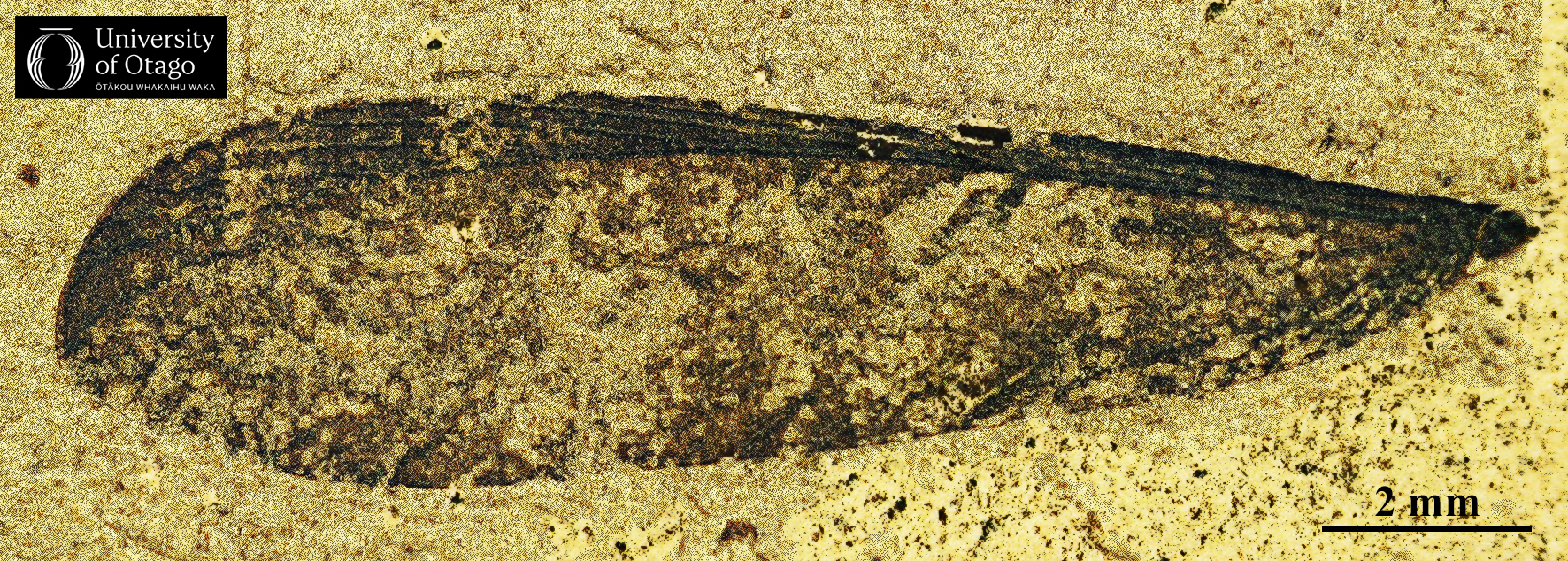56 Diverse primitive termites are Aotearoa’s lost social insects
Arthropoda, Blattodea: Stolotermes kupe
Some of the unexpected insect finds at Foulden Maar in the past two decades are isolated wings from a diverse range of termites.

Isolated forewing of the dampwood termite, Stolotermes kupe (OU 44560). Image credit: U Kaulfuss. |
Termites, formerly placed in the order Isoptera but now included in Blattodea with the closely related cockroaches, have the longest fossil record of any eusocial insects. In modern temperate and tropical ecosystems, termites are very important recyclers of organic matter.
Aotearoa New Zealand today has a very low diversity of termites: just three native species in two genera and families. In contrast, Australia has about 270 species in five extant termite families.
Although termites have a bad press, known for eating through wooden structures, the three New Zealand natives cause little damage. The two species of Stolotermes live in dampwood such as dead and decaying stumps and logs of a variety of native trees including kauri, rimu, beech and broadleaf and can also be found in exotic trees such as radiata pine and macrocarpa. The distantly related Kalotermes brouni makes its habitat in drywood. All three are inconspicuous components of the New Zealand fauna, forming small colonies of up to a few hundred individuals, in both native and exotic trees, mostly in the North Island.
The first termite fossil found at Foulden was an isolated complete forewing of a species of the primitive dampwood genus Stolotermes, showing that these termites have probably been in New Zealand for the past 23 million years. It was different enough from the living species to be given a new name, Stolotermes kupe. This was the first direct evidence for fossil termite in New Zealand, although Joan Sutherland, a former Otago Geology graduate, described and illustrated silicified hexagonal-shaped fecal pellets ‘similar to those of K. brouni’ from specimens of silicified wood of Early Miocene age from near Auckland.
But this was just the beginning. Since 2010, another five genera and species of termites have been described from Foulden Maar. All are isolated wings, preserved as part and counterpart (meaning one half of the fossil is on one split block and the other half on the opposite side) – both are needed to fully understand the characteristics of the fossils.
Four of these new termites proved to be so different from all other living and fossils termites known that they have been placed in new genera as well as new species. Named from the area around Foulden Maar, the taxa are called Waipiatatermes matatoka (from the Waipiata Volcanic Field in which the maar is located); Taieritermes krishnai (from the nearby Taieri River); Otagotermes novazealandicus from Otago; and Pterotermopsis fouldenica for Foulden Maar.
They add a new component to what we know of the ecology of the rainforest that once surrounded Foulden Maar – there must have been plenty of dead and decaying trees able to support a diverse range of termites that have since become extinct, probably due to changing climates over millions of years.
—Written by Daphne E Lee and Uwe Kaulfuss
| Specimen number: OU 44560 | Age: 23 million years old (early Miocene, Waitakian stage) |
| Locality: Middlemarch, Otago | Rock Formation: Foulden Hills Diatomite |
| Collected by: U Kaulfuss | |
| Citation: Kaulfuss U, Harris AC, Lee DE. 2010. A new fossil termite (Isoptera, Stolotermitidae, Stolotermes) from the Early Miocene of Otago, New Zealand. Acta Geologica Sinica 84:705–709. doi.org/10.1111/j.1755-6724.2010.00275.x | |
A former crater lake with abundant diatoms, and now a fossil site known for diatomite and famous for high-quality fossil preservation. Located near Middlemarch in Otago, New Zealand. See: Fossil Treasures of Foulden Maar.
An advanced level of social organisation.
The variety of life.
Sutherland JI. 2003. Miocene petrified wood and associated borings and termite faecal pellets from Hukatere Peninsula, Kaipara Harbour, North Auckland, New Zealand. Journal of the Royal Society of New Zealand 33:395–414. doi.org/10.1080/03014223.2003.9517736

